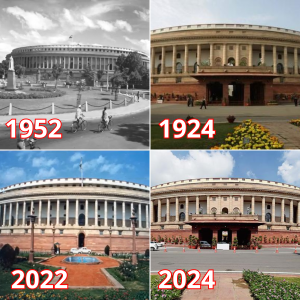
Then: The Parliament of India, also known as the Sansad Bhavan, is a symbol of India’s democratic framework. Designed by British architects Sir Edwin Lutyens and Sir Herbert Baker, the foundation stone was laid on February 12, 1921. The construction of the building was completed in 1927, serving as the legislative chambers for the Imperial Legislative Council under British rule. The architectural style is a blend of classical and Indian elements, featuring a circular structure with 144 columns, a central dome, and expansive gardens. The building has three main chambers: the Lok Sabha (House of the People), the Rajya Sabha (Council of States), and the Central Hall, which has witnessed many historic events, including the declaration of India’s independence in 1947.
Now: Today, the Parliament of India remains a central hub for the country’s legislative processes. The original building continues to stand proudly in the heart of New Delhi, though it now functions alongside the newly constructed Parliament House, inaugurated in 2022 as part of the Central Vista Redevelopment Project. The new Parliament building is modern, equipped with advanced technology and enhanced seating capacity, reflecting India’s growth and aspirations. It maintains architectural continuity with the original structure while incorporating sustainable and eco-friendly design principles.
Reflection: The transformation from the historical Sansad Bhavan to the contemporary Parliament House symbolizes India’s journey from colonial rule to a robust, independent democracy. The original building, with its rich history and architectural grandeur, stands as a testament to India’s past, while the new structure signifies progress and modernization. Together, they represent the dynamic nature of Indian democracy, blending tradition with innovation to serve the needs of the world’s largest democracy.





